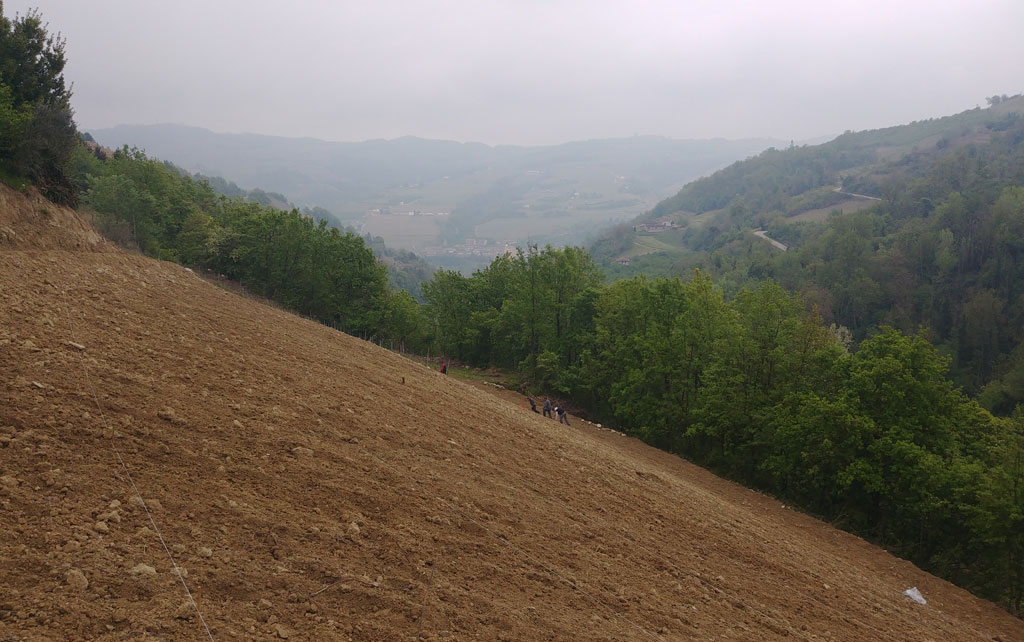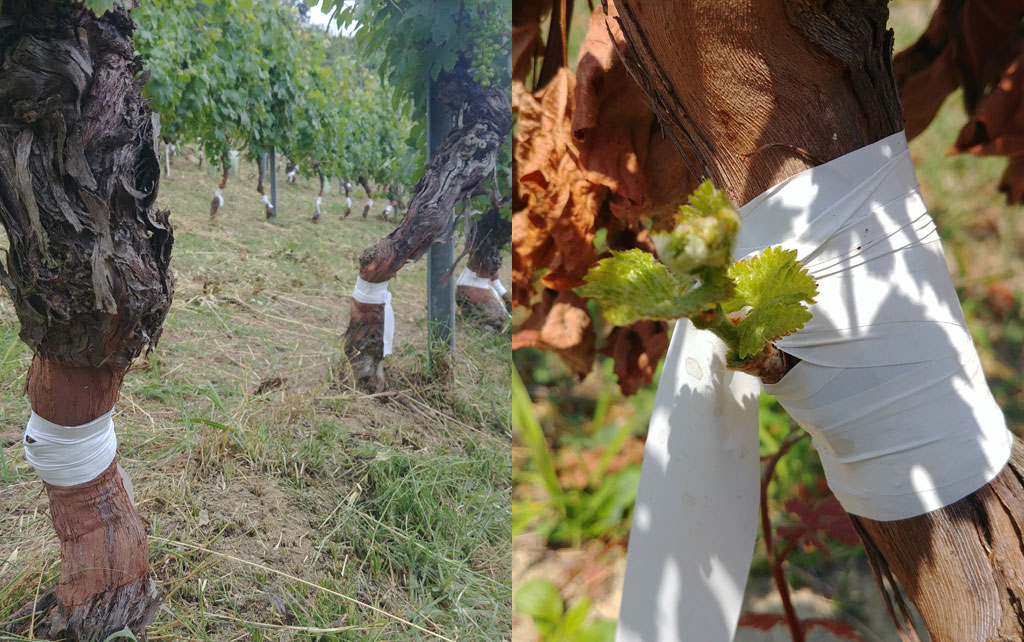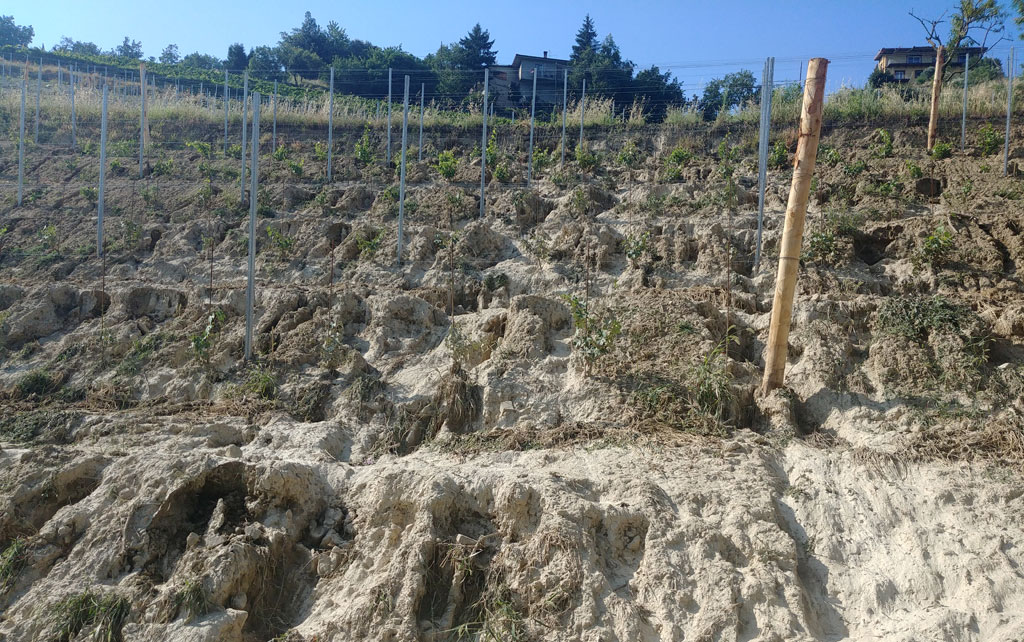|
VINEYARDS
|
|
(continues from the previous page)
|
Favorita – the planting material was taken in 2020 from another vineyard in Cossano Belbo (the so called “sélection massale”) facing East and planted in the 1970-s at an altitude of 520 m (1700 ft) a.s.l. I don’t know which particular clone of Favorita this one is, the latter being a local biotype of the varietal Vermentino Bianco or Rolle or Malvoisie à gros grains, popular all over the Northern coast of the Tirrenian Sea (Tuscany, Liguria, French Provence). But I’ve been working with this vineyard since 2015 (see A♦Quila 2019 & also A♦Quila 2020) and like very much the floral and spicy character of the wines it is capable of producing. It appeared to be a very capricious vine – only 20% of the grafted material survived. Grafted on SO4.
Moretto – also a “sélection massale” from a vineyard in Tortona area, the last “surviving” vineyard of this variety in Piedmont of 0.12 ha, being itself overgrafted on an old Croatina vineyard in 2018. This is the so called «Mexican Nebbiolo», I’ve also been taking and vinifying some of the grapes from this vineyard since 2019 (see MX♦Quila 2019, also MX♦Quila 2020 and also MX♦Quila BIO 2021). The abundance of synonyms of this varietal (Moretto is also one of them, not the official name), around 45 (like André, Crovin, Legno Bianco, Neirano among them as well as Aglianico Dolce & even Nerello), is a proof of its previous popularity in Piedmont. In 1970 there were 1100 ha of this variety in Piedmont that’s exactly the surface of the Arneis as of the 2020 census. Unfortunately nearly all of it has been pulled off and replanted under the EU CMO restructuring plan of 2009 – 2014. In Piedmont it has never been released as a varietal wine. Due to its main characteristics (short vegetative season, early ripening and abundant production) it used to play only a “supporting” role for the more sensible and later ripening varietals like Dolcetto and Barbera. The locals call it “uva balorda” – the dumb grape as it used to be planted and to give acceptable results in the worst lands. In Mexico (mainly Baja California), where it’s planted at the best sites and is treated “like a king”, it gives completely different results and ripens 3 weeks later than in Piedmont – a curious fact given the huge Huglin index difference between the two regions. Moretto, together with Nebbiolo is one of the only 9 “ancestor” varietals of Northern Italy, that had given light (are parents) of at least 5 existing modern varietals. According to the latest genetic analyses Moretto is the “father” of Malvasia di Casorzo, the “grand-father” of Slarina and Uvalino, the latter being a “half-brother” of Arneis and both of them (Uvalino & Arneis) are “grand-sons” of Nebbiolo. Grafted on SO4.
Nebbiolo
(I) Overgrafting – this is a technique used to replace the upper part of a live vine with another varietal. A single bud of the new variety, that has been collected in winter before the season starts is “implanted” under the lower layer of the vine’s trunk bark during the most active part of the season (in June). By the end of the season the bud produces a long cane that starts to produce grapes the following year. So compared with replanting this is a faster method, but it needs healthy vines with good root system. We took the material form our old Nebbiolo plot just above the Dolcetto vineyard that was overgrafted. We have no idea which Nebbiolo clone is that, but it has been well adapted to the soil & climatic conditions of Madonna della Rovere as has been growing there for more than 50 years.
(II) New plantings – for those we made a clonal selection at a nursery in the Langhe. At present there are around 10 different registered phenotypes and 46 clones of Nebbiolo. When choosing what to plant we considered the origin, the production characteristic and the affinity with the rootstocks that are best for the soils in Madonna della Rovere.
CVT 142 grafted on 1103 Paulsen (1500 sq.m. / 0.37 acres) This clone was selected in Neive (Barbaresco area) in 1990 and is the less productive of all the CVT clones. The phenotype is Lampia with small and deeply engraved leaves. It’s also less vigorous than other clones. That were the reasons behind our decision to plant on the driest part of the estate with poor white sand and blue marl soils
CVT 180 grafted on Rupestris du Lot (2900 sq.m. / 0.72 acres) This clone was selected in Barbaresco in 2003, it’s also of the Lampia phenotype, but the “regular” one. We tended to select clones from Barbaresco area as the soils of Cossano are similar (more sandy than Barolo area). This is the earliest clone of all that we planted, with medium vigor and productivity. That’s why we chose to plant it in the upper part of the estate on a soil rich in red clay. Also, this is one of the “wettest” parcels as it “collects” the drainage waters from the other vineyards above it. This is the only parcel with “reddish” soils (rich in iron) in the whole estate.
CVT 185 grafted on 1103 Paulsen (450 sq.m. / 0.11 acres). This clone is also a Lampia phenotype selected in Barbaresco in 2003. It’s early ripening and medium-low production clone. It’s planted below the CVT 180 on a less steep slope, the soil here is a mix of yellow sand, blue marl and red clay.






